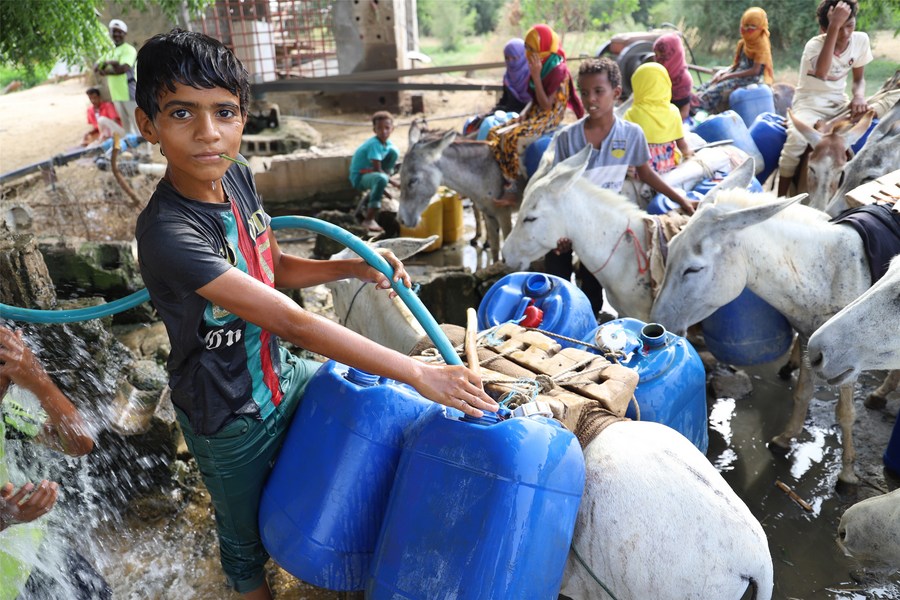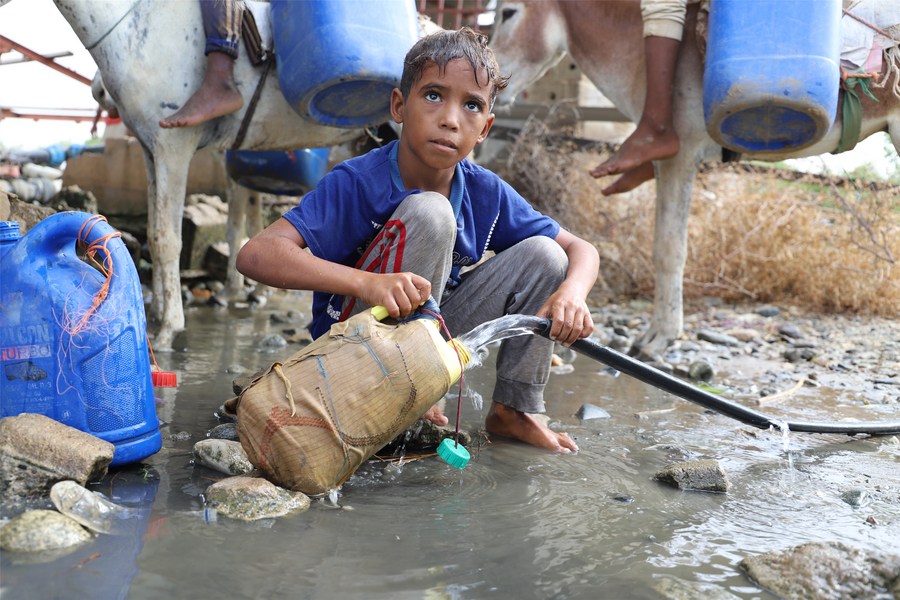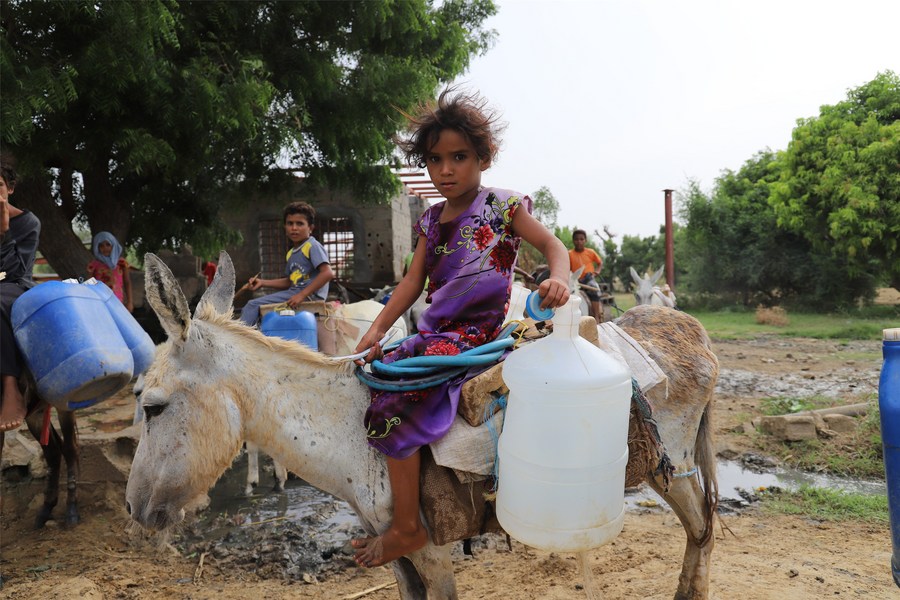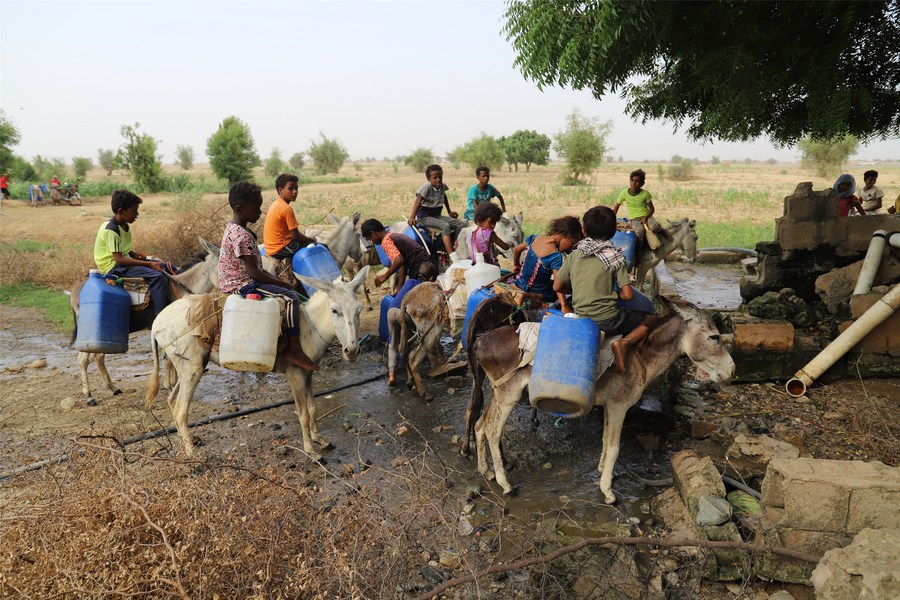 Yahya Ahmed (F) fills plastic bottles with water in Hayran District in Hajjah province, Yemen, on July 10, 2020. (Xinhua/Mohammed ALwafi)
Yahya Ahmed (F) fills plastic bottles with water in Hayran District in Hajjah province, Yemen, on July 10, 2020. (Xinhua/Mohammed ALwafi)
As wells dry up, Yemeni children go long distance with donkeys to fetch water, even not clean, due to crisis caused by war.
HAJJAH, Yemen, July 27 (Xinhua) -- In northern border villages of war-torn Yemen, children ride donkeys for long journeys of kilometers to fetch water for their families.
Many wells in Al-Sada village of Hayran district in the northwestern province of Hajjah had dried up.
"We are suffering from a water crisis, as getting water is not an easy task. It requires long-distance travel and I need to wait for hours among the crowds. In the end, I get undrinkable water," 12-year-old Yahya Ahmed told Xinhua, in front of the only well in the arid area.
"This water is not clean and we want a solution to the water problem in our villages," Yahya said after filling his cans strapped on the back of the donkey.
 A child fills plastic bottles with water in Hayran District in Hajjah province, Yemen, on July 10, 2020. (Xinhua/Mohammed ALwafi)
A child fills plastic bottles with water in Hayran District in Hajjah province, Yemen, on July 10, 2020. (Xinhua/Mohammed ALwafi)
"I know this is contaminated water but we have no choice," he said while starting his long trek home along with other dozens of children.
The collected water could only cover the needs of Yahya's eight-member family for one day, including drinking. But during the hot summer, he sometimes has to head to the well twice a day.
According to the residents, the new wells drilling projects in the district had stopped because of the war.
Even in bigger cities, residents have to go long distances to fetch water from charity tanks, which lack periodic sterilization. Projects of drilling new wells in the northern cities had also stopped too due to the war.
 A girl waits to get water from a local pump in Hayran District in Hajjah province, Yemen, on July 10, 2020. (Xinhua/Mohammed ALwafi)
A girl waits to get water from a local pump in Hayran District in Hajjah province, Yemen, on July 10, 2020. (Xinhua/Mohammed ALwafi)
According to the UN aid agencies, more than 17 million people in Yemen don't have access to safe water.
The contaminated water has caused the spread of many diseases across Yemen, where more than five years of war have destroyed over half of the country's health system and caused the collapse of its economy.
The epidemics have killed thousands and sent millions to the hospitals.
Since April 2017, cholera and acute watery diarrhea epidemic in Yemen have caused an estimated 2 million suspected cases and 3,500 associated deaths, mostly children, according to a recent joint statement by the World Health Organization and the United Nations Children's Fund.
 Children wait to get water from a local pump in Hayran District in Hajjah province, Yemen, on July 10, 2020. (Xinhua/Mohammed ALwafi)
Children wait to get water from a local pump in Hayran District in Hajjah province, Yemen, on July 10, 2020. (Xinhua/Mohammed ALwafi)
The outbreak in Yemen remains the largest cholera in the world, they said.
Yemen has been mired in war since late 2014, when the Iran-backed Houthi group seized control of much of the country's north, forcing the Saudi-backed government of President Abd-Rabbu Mansour Hadi out of the capital Sanaa.
The Saudi-led military coalition intervened in the Yemen conflict in March 2015 to support Hadi's government.
The war has since killed tens of thousands of people, mostly children, displaced 3 million, destroyed the country's agricultural industry and pushed over 20 million to the brink of starvation. ■



